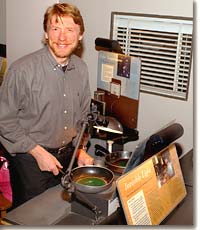Rob Semper
The Exploratorium, a science museum in San Francisco, is known for being a fun place to learn about science, filled with fascinating exhibits and scientific toys for all ages. It's also an interesting place to work, says physicist Rob Semper, who is now the Executive Associate Director. In his position at the Exploratorium, Semper gets to interact with scientists and educators, learn new things about science, travel to amazing lab sites around the world, and oversee the production of live webcasts on topics from the science of music to the transit of Venus.

Rob Semper cooks up an experiment exhibit.
Semper has worked at the Exploratorium since 1977, and now manages many of its projects in his role as Executive Associate Director. He is also head of the Exploratorium's Center for Learning and Teaching, which offers programs in teacher professional development, youth programming, publishing, media and Internet development. In the past ten years Semper has been working on extending the museum beyond its walls, through webcasting and other media. These projects often take Semper all around the world, something he really loves about the job, since he gets to learn about science and nature as well as experience new cultures.
One such project he and a team recently completed was called Origins, which takes visitors to the website on a “virtual field trip” to six laboratory locations, from the world of high energy particle physics at CERN in Geneva, Switzerland, to the biodiversity in the jungles of Belize, to the extreme environments of Antarctica. The site includes live webcasts and interviews with scientists, as well as explanations of the ideas behind the science and pictures of the lab environment and the equipment. “The idea was to give people through the web a sense of what it's like to be doing science in the real world,” says Semper.
Semper traces his interest in science back to his visits to science museums when he was young. He grew up in New York, visiting the American Museum of Natural History and the Planetarium, and was also intrigued by television science shows like Mr. Wizard. Semper also says he also had good science teachers in elementary school, and his father pursued hobbies like radio and electronics. “So I was always interested in science and I kept being curious about the world,” he says.
Electricity and magnetism especially captivated Semper. “That was really what pulled me into the world of physics,” he says. Semper also enjoyed building experimental apparatus. He went to graduate school at Johns Hopkins, where he studied solid state physics, then went on to use his skills in building detectors and instruments to work in high energy physics for a few years.
When a job at the Exploratorium opened in 1977, Semper decided to take it. “I was always interested in teaching nonscientists science, and I was also interested in working a lot with people,” says Semper, explaining his reasons for moving out of the lab and into the museum.
Since starting at the Exploratorium, Semper has had the chance to work on many different projects in a variety of roles. “I've been able to do something new every so often, and that's kept me going,” he says. During his early years there, he worked on exhibit development, and used his shop and laboratory skills in building some of the exhibits. Later Semper spent some time working on education and teacher development programs, and more recently he's been working on extending the museum experience outside of the physical museum, through online exhibits and in publications.
As Executive Associate Director, he does a lot of management and oversight of many projects, drawing on knowledge and skills in science, education, and design. “On a day to day basis, I end up doing things like working with our team to design remote coverage of an eclipse from some interesting part of the world, or trying to understand what it means to professionally develop a teacher work force that's smart about science. My days run between policy work to doing fund raising to working with scientists and ideas.”
He says he likes the educational projects, which bring him close to the learner. “The educational work that we're doing is really connected very much to the real world of education and people, and it's very much focused on the learner. In a sense the audience is what propels us to do our work.”
Another one of the things he likes most about working at the museum is the creative social environment, where he can interact with lots of different people and learn new things about science all the time. “In general the museum is made of a lot of scientists, educators, media developers, artists, and tinkerers,” he says, “We have an environment where a lot of ideas are bubbling up.”











